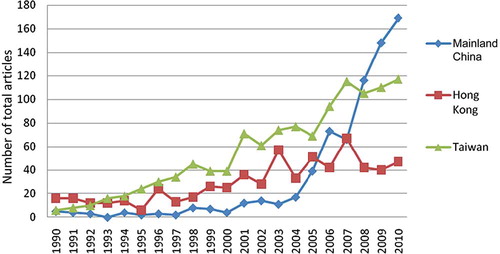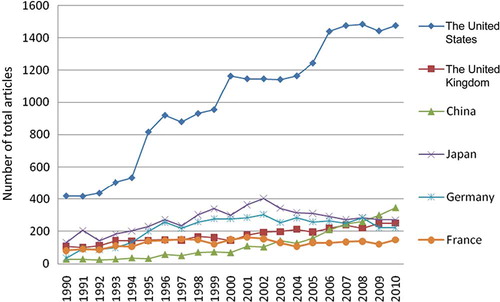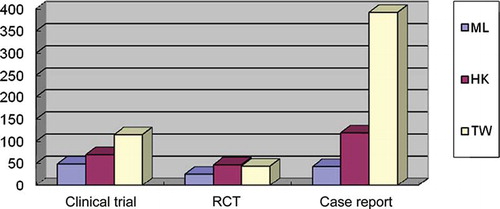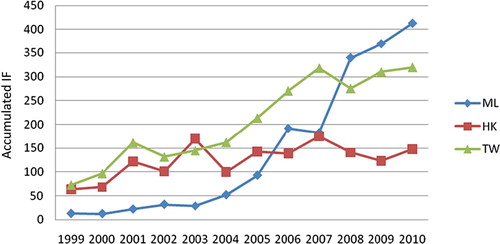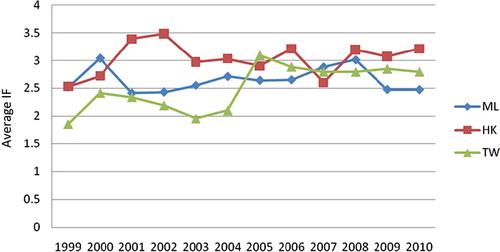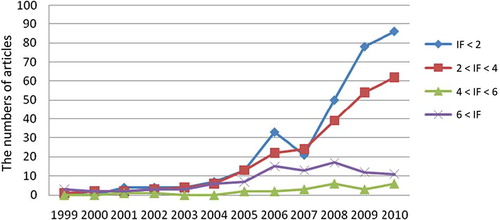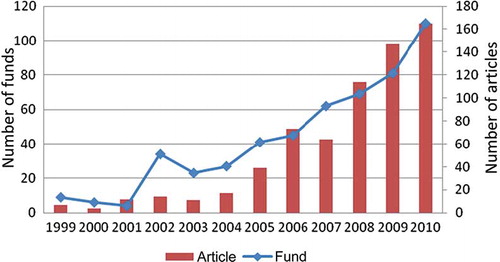Abstract
Background: To study the trend of clinical and basic research output in the field of nephrology in China during the past 20 years. Methods: The journals listed in the “Urology and Nephrology” category of Science Citation Index Expanded (SCIE) subject categories were selected. The papers were retrieved by searching the PubMed database. Mainland China (ML), Hong Kong (HK), and Taiwan (TW) were chosen as investigative regions compared with other developed countries. Geographical difference in publications in ML was analyzed. The change between clinical and basic research papers was compared. The accumulated or average impact factor (IF) and the number of papers published in the 10 most impacted journals were calculated to determine the quality of papers. Results: The research output in the field of nephrology in ML developed markedly in the last 7 years (an average annual increase of 54% from 2004); ML exceeded TW and HK since 2008. The research output born in ML was mainly from five cities, for example, Beijing, Shanghai, Nanjing, Guangzhou, and Hangzhou, which accounted for 72% of the total. Since 2001, clinical research papers increased yearly by 11.55, and the basic research papers increased by 4.55. However, clinical trials were still limited. In 2010, ML had the highest accumulated IF and the lowest average IF. ML had the second highest number of publications in the 10 top-ranking nephrology journals among the three regions. Conclusions: China has made a remarkable progress in the field of nephrology. Clinical researches have promoted the development of nephrology. The quality of research papers in China needs further improvement.
INTRODUCTION
The prevalence of chronic kidney disease (CKD) in China is about 9–13%.Citation1 China, therefore, holds the largest group of CKD population in the world. This is of course becoming a severe medical and social burden.Citation2 There are quite a few differences between China and western countries in CKD etiology, genetic background, and risk factors.Citation3–5 Therefore, it is necessary to strengthen the clinical and basic researches on CKD in China to make further progress toward prevention and treatment of CKD in the country.
By the end of 2010, Chinese Society of Nephrology celebrated its 30th anniversary. The Society was established 20 years after the International Society of Nephrology was established. It was in the year 1978 that Mainland China (ML) initiated the establishment of nephrology subspecialty in hospitals.Citation6 With the high economic growth, China has achieved tremendous success in general scientific research.Citation7 At present, China holds the second position in scientific publications in the world.Citation8 Nephrology in China has also improved dramatically, especially in the recent 7 years. The scientific publications reflect the scientific output of a country to some extent.Citation9 Bibliometric analysis has been used as a tool to compare research productivity between different academic institutions.Citation10 Until recently, no study has analyzed nephrology research in China. This study compares nephrology research performance between different regions of China in the last 20 years, based on publications listed in PubMed in both quantitative and qualitative aspects. We particularly focused on the progression of clinical scientific research in the field of nephrology.
MATERIALS AND METHODS
Journals Selection and Inclusion Criteria
The nephrology journals enrolled in this study fulfill the following three criteria: (1) the journal should be listed in the “Urology and Nephrology” category of Science Citation Index Expanded (SCIE) subject categories by the Institute for Scientific Information (ISI); (2) the journal should be indexed in the PubMed database in which the publication language is English; and (3) the journal should be listed in the Journal Citation Reports (JCR) 2010 and should have an impact factor (IF) in 2010.
Based on the above criteria, the following journals were excluded: (1) pure urology journals and nursing journals, such as “Nephrology Nursing Journal”; (2) non-English journals, such as “Phorology & Therapeutique”; and (3) journals without IF.
In addition, we added three journals, for example, “Exp Nephrol,” “Nephron,” and “Nat Clin Pract Nephrol.” The former two journals have been changed to three journals: Nephron Physiol, Nephron Clin Pract, and Nephron Exp Nephrol in 2004. “Nat Clin Pract Nephrol” was renamed “Nat Rev Nephrol” in April 2009. Actually, the International Standard Serial Number (ISSN) of these journals cannot be found in SCIE.
In total, 35 journals related to nephrology were selected.
Publications Retrieval Strategies
The PubMed database was searched in June 2011 to find the number of articles originating from ML, Hong Kong (HK), and Taiwan (TW) during 1990–2010. The search address terms used were “(China [Affiliation]) NOT (Hong Kong [Affiliation]) NOT (Taiwan [Affiliation]),” “(Hong Kong [Affiliation]),” and “(Taiwan [Affiliation])”. The publication date terms used were “1990/01/01 to 2010/12/31.” We also examined the number of articles in nephrology from the top-ranking countries—the United States, Japan, Germany, the United Kingdom, and France—and compared with that from China. All the data of China come from the sum of those from ML, HK, and TW.
The ISSN (Print) was used to perform searches in PubMed. The search terms used by nephrology journals with IF scores were “1046-6673 OR 0085-2538 OR 1745-8323 OR 0272-6386 OR 1555-9041 OR 1062-4821 OR 1931-857X OR 0931-0509 OR 0250-8095 OR 0270-9295 OR 0894-0959 OR 1660-2137 OR 0896-8608 OR 0302-5144 OR 0253-5068 OR 1660-2110 OR 1548-5595 OR 1660-2129 OR 0301-0430 OR 1420-4096 OR 1320-5358 OR 1121-8428 OR 1051-2276 OR 0301-1623 OR 0036-5599 OR 0886-022X OR 0090-2934 OR 0028-2766 OR 1073-4449 OR 1018-7782 OR 0931-041X OR 1759-5061 OR 1342-1751 OR 1492-7535 OR 1744-9979.” Articles that showed the first author’s affiliation (ad) with the three regions were considered as research output from the regions.
Types of nephrology articles were categorized as basic research or clinical research as defined by the research subject type of “animal” or “human” according to the species in PubMed. The number of articles in the fields of clinical trials, randomized controlled trials (RCTs), and case reports were generated according to the publication types in PubMed.
To evaluate the regional difference of articles published in ML, research output from major cities in China was further analyzed.
Articles related to nephrology were first extracted independently by two reviewers (Jia Kou and Yan Zhang), and the discrepancies in final data extraction were resolved by viewing the titles, abstracts, and full text if necessary.
IF Analysis
To compare the quality of the research articles, the retrieved articles were analyzed based on the IFs generated according to JCR 2010 established by the ISI.Citation11 Three factors were evaluated: the accumulated IF, the average IF, and the articles published in the top 10 high-impact nephrology journals.
Statistical Analyses
Statistical analyses were performed using SPSS 17.0 (SPSS Inc., Chicago, IL, USA). The correlation analysis was performed to determine the significant relationship between the number of articles and the amount of funding from ML. Kruskal–Wallis test was used for detecting the difference among the three regions, and Mann–Whitney test for detecting the difference between the two when necessary. The test of significance was two-tailed and the value of p < 0.05 was considered significant.
RESULTS
Total Number of Articles and Trends
By searching articles from PubMed database, 85,184 published articles were retrieved from the selected 35 journals during the period from 1990 to 2010. There were 2491 articles (2491/85,184, 2.9%) from ML (703/2491, 28.2%), TW (1160/2491, 46.5%), and HK (628/2491, 25.3%).
The number of articles from the three regions increased in the past 20 years, and what is interesting is that the increment is not remarkable before 2004 but become obvious after 2004, especially in ML. Since 2004, an average annual increase in the number of articles is 25.33 from ML, 2.33 from HK, and 6.66 from TW. ML had the lowest number of articles among the three regions before 2006, but exceeded that of HK since 2006. From 2008 till now, the number of articles from ML was always the highest, followed by TW and HK ().
Total Number of Articles from Different Countries
Worldwide, the United States, Germany, Japan, France, and the United Kingdom were selected and analyzed. Between 1990 and 2010, the total number of publications from the United States ranked first, followed by Japan, Germany, the United Kingdom, France, and China. Since 2009, the number of articles from China exceeded those from France, Germany, Japan, and the United Kingdom ().
Clinical Research and Basic Research Articles
shows the changes in the number of articles in clinical research and basic research among the three regions. From 1990 to 2010, all the three regions showed that the number of articles in clinical research were more than those in basic research. In ML, the number of articles in clinical research were 510, while that in basic research were 202; in HK, the number of articles in clinical research were 587, while that in basic research were 51; and in TW, the number of articles in clinical research were 1017, while that in basic research were 154.
Figure 3. The trend of numbers of clinical articles and basic articles from Mainland China (ML), Hong Kong (HK), and Taiwan (TW).
Notes: Type C means type of articles categorized as clinical research. Type B means type of articles categorized as basic research.
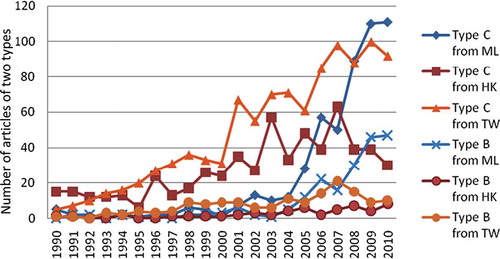
It should be addressed that the number of articles in both clinical research and basic research from ML have exceeded those from TW or HK since 2008. From 2001 to 2010, there was an average annual increase of 11.55 articles in clinical research and 4.55 articles in basic research, respectively ().
Clinical Trial, RCT, and Case Report
By analyzing the total number of articles in the recent 20 years, it was found that ML had the lowest number of articles in clinical trial, RCT, and case report among the three regions. HK published more RCT papers than ML and TW. Interestingly, TW published 392 case reports between 1990 and 2010, much more than ML (43 cases) and HK (119 cases). The same trend was found for clinical trials ().
Nephrology Publications from Different Cities in ML
As illustrated in , articles originating from Beijing were mostly from ML, which accounted for 31% of the whole publications, followed by Shanghai (15%), Nanjing (12%), Guangzhou (9%), and Hangzhou (5%). Articles from Chengdu and Jinan accounted for 3%. Changsha accounted for 4% and Chongqing accounted for 2%.The above-mentioned nine cities had 84% of the total publications. Five cities including Beijing, Shanghai, Nanjing, Guangzhou, and Hangzhou had predominant positions. These five cities comprised nearly three-fourths of the total amount of published articles from ML ().
Accumulated and Average IFs
As expected, the accumulated IF from the three regions increased as the number of articles increased: ML exceeded HK and TW since 2008. The average IF of the three regions did not present a significant increment but an undulation. The average IF of HK was the highest in most years. The total accumulated IF of articles from TW (2470.398) was much higher than ML (1739.332) and HK (1488.906). However, HK had the highest total average IF of 3.03, followed by ML 2.73 and TW 2.64 ( and ).
High Impacted Nephrology Journals
A total number of 1069 articles from the three regions were published in the 10 top-ranking nephrology journals, according to JCR 2010, during the period 1999–2010. Ninety articles were published in J Am Soc Nephrol, the highest IF nephrology journal. TW published 474 articles in the high impacted nephrology journals, while HK and ML had 276 and 319 articles, respectively, in the top 10 journals ().
Table 1. Articles published in the 10 most impacted journals from ML, TW, and HK.
We divided the nephrology journals into four groups based on different IFs of JCR 2010: IF < 2, 2 < IF < 4, 4 < IF < 6, and IF > 6. Since 2005, the number of articles from journals with IF < 2 and 2 < IF < 4 increased rapidly, especially those with IF < 2. In contrast, the number of articles from journals with 4 < IF < 6 and IF > 6 did not increase remarkably. This revealed that the increment of articles from ML mainly depended on the journals with IF < 4 ().
Funding from NSFC for Nephrology Research in China
Most of the funding for nephrology come from the National Natural Science Foundation of China (NSFC) and the Ministry of Science and Technology of China. Overall, the funding from NSFC for nephrology research has increased about 10-fold in the past 10 years (). In addition, nephrologists in China can also obtain funding from the Ministry of Education, the Ministry of Health, and local governments. We discovered that the number of articles from ML changed synchronously with the amount obtained from the fund. There is a positive correlation between the number of articles and the number of funds (r = 0.956, p < 0.01) ().
DISCUSSION
To the best of our knowledge, this is the first article dealing with scientific publications in the field of nephrology in China. The major regions of China—ML, TW, and HK—had a steady increase in trend in the past 20 years. It seems exciting that ML has improved the research in the field of nephrology and the articles in international journals have increased very rapidly during the last 7 years. From 2008 onward, the number of articles published from ML exceeded those from HK and TW. In 2009, the number of articles from China exceeded those from France, Germany, Japan, and the United Kingdom.
This change could be explained based on the following several reasons:
| (1) | China in recent years is prospering rapidly economically to become the second-largest economy in the world.Citation12 The overall environment for academic research has been significantly improved based on the 30 years of sustained economic development. Efforts to support research projects have increased markedly.Citation13 The Chinese government has tripled the amount of its research and development funding; it projects a further fourfold increase in the country’s total research and development expenditure from now until 2020.Citation13 | ||||
| (2) | With such major socioeconomic impetus, a remarkable development in scientific research has also inevitably happened. One of the basic tenets of scientific growth is the ability to share scientific findings with the rest of the world through publications in peer-reviewed journals.Citation14 According to the Global Research Report from Thomson Reuters, China’s output of scientific research papers had “explosive” growth since 2004.Citation15 The number of peer-reviewed SCI papers published by China had increased from 20,000 articles in 1998 to more than 112,000 in 2008. Since 2006, the number of articles from China exceeded those from France, Germany, Japan, and the United Kingdom. China is now second only to that of the United States in terms of academic papers published, and will take first place by 2020 if current trends continue.Citation16 The results of our study in the field of nephrology showed the same trend. | ||||
| (3) | In recent years, more young nephrologists, with well-recognized experience and notable achievements in nephrology research, have returned to China from the United States, Europe, and Japan, and are now actively involved in the promotion of research in China. Chinese nephrologists have recognized it is important to publish more papers in international journals.Citation17 International academic exchanges have been strengthened. Participants and abstracts submitted to international conferences, such as International Society of Nephrology (ISN), American Society of Nephrology (ASN), and European Renal Association - European Dialysis and Transplant Association (ERA-EDTA), increased gradually. Besides, serving in the international academic organizations, establishment of ISN Sister Renal Centers, and actively organizing continuing medical education also increased significantly in the recent years. These activities promoted the development of nephrology in China. | ||||
| (4) | It should be emphasized that ML scholars began to shift interest to clinical study of kidney disease. Multiple regional epidemiological studies and cohort studies were carried out with the advantage of utilization of disease resources. Since 2008, the number of articles in clinical research from ML has exceeded that from TW and HK. Therefore, clinical research promotes the development of nephrology in China. | ||||
Although the number of articles from ML grew rapidly especially in the last 7 years, the following issues should be noted:
| (1) | The number of papers published is still significantly lagging behind that of the United States.Citation18 | ||||
| (2) | High-quality research papers are still limited in China. Although IF is not the optimal parameter for determining the quality of articles, and new parameters have been proposed in recent years, it is at present the best available parameter for determining the quality of studies.Citation19,20 According to JCR 2010, ML had the highest accumulated IF and the lowest average IF of articles among the three regions. | ||||
| (3) | Quantitative and qualitative indicators of clinical trial from ML need to be further improved. Worldwide, the number of RCTs published in nephrology is fewer than all other specialties of internal medicine.Citation21 There is an increased awareness to perform CKD investigation and cohort study in ML. However, the quantity of clinical trial, especially RCT, is still rather limited. Several factors determine the quality and quantity of RCT in the field of nephrology.Citation22 Nevertheless, China with a population of 1.3 billion has a huge number of subjects. Chinese people are more compliant than the western population.Citation23 In addition, trials in China are much cheaper to conduct.Citation24 Evidence-based medicine has developed quickly in ML.Citation25 The number of clinical trials registered in China is increasing according to the data from the Chinese Clinical Trial Registry.Citation26 However, based on the results of our study, both case report and clinical trial originated from ML were the least among the three regions of China. The low publication rate of the registered Chinese trials may account for this phenomenon to some extent.Citation27 | ||||
| (4) | China’s huge territorial expanse and an imbalance in regional economic developments have resulted in an uneven distribution of scientific research output. Geographical distribution analysis showed papers published from ML are located mainly in Beijing, Shanghai, Nanjing, Guangzhou, and Hangzhou, accounting for 74% of the total articles. Beijing accounted for 31% of the total articles. In addition, the number of papers published has a correlation with the number of local doctors. Preliminary statistics results showed that these regions have more nephrologists than other regions in ML (unpublished data). CKD screening researches were carried out recently in various parts of China. The epidemiological data showed that the average incidence of CKD was around 9–13%.Citation28–30 Therefore, the country cannot afford nationwide prevention and control task of CKDs by doctors from the few cities. Clinical and research levels should be improved to a larger extent nationally, especially in remote developing areas. | ||||
In conclusion, China has made a remarkable progress in the field of nephrology based on recent year’s research output analysis. The number of research papers on kidney disease from China showed a continued growth trend in the recent 20 years, especially in the last 7 years, which ranks second in the world. Clinical researches have promoted the development of nephrology. The quality of research papers in China needs further improvement, especially in randomized clinical trials. The research papers from China showed an obvious uneven geographical distribution. We wish China has the opportunity to improve research output not only in quantity, but also in quality in the future.
ACKNOWLEDGMENTS
The authors thank all the members of State Key Laboratory of Kidney Diseases. This work was supported by the NSFC (81070267, 81171645), and the Scientific Program of Beijing (D09050703560907, D09050104310000).
Declaration of interest: The authors report no conflicts of interest. The authors alone are responsible for the content and writing of the paper.
REFERENCES
- Xie Y, Chen X. Epidemiology, major outcomes, risk factors, prevention and management of chronic kidney disease in China. Am J Nephrol. 2008;28:1–7.
- Zhang W, Gong Z, Peng X, Tang S, Bi M, Huang W. Clinical characteristics and outcomes of rural patients with ESRD in Guangxi, China: One dialysis center experience. Int Urol Nephrol. 2010;42:195–204.
- Dialysis and Transplantation Registration Group. The report about the registration of dialysis and transplantation in China. Chin J Nephrol. 1999;17:77–78.
- Cai GY, Chen XM. Immunoglobulin A nephropathy in China: Progress and challenges. Am J Nephrol. 2009;30:268–273.
- Wang H, Zhang L, Lv J. Prevention of the progression of chronic kidney disease: Practice in China. Kidney Int. 2005;94:S63–S67.
- Lin SY. Nephrology in China: A great mission and momentous challenge. Kidney Int. 2003;63(Suppl. 83):S108–S110.
- Han Q, Chen L, Evans TG, Summerskill W. Recent scientific health developments in China. Lancet 2010;375:1055–1056.
- Zhou P, Leydesdorff L. ISSI Newsletter No. 13. March 2008:7–9.
- Lawrence PA. The politics of publication. Nature 2003;422:259–261.
- Wallin JA. Bibliometric methods: Pitfalls and possibilities. Basic Clin Pharmacol Toxicol. 2005;97:261–275.
- ISI Journal Citation Reports, Institute for Scientific Information. 2006. Available at: http://isiknowledge.com. Accessed April 20, 2008.
- http://www.nytimes.com/2010/08/16/business/global/16yuan.html. Accessed February 22, 2011.
- Wells WA. The returning tide: How China, the world’s most populous country, is building a competitive research base. J Cell Biol. 2007;176:376–401.
- Goh KL, Farrell GC. Publications from China: The sleeping giant awakens. J Gastroenterol Hepatol. 2008;23:341–343.
- Thomson Scientific. Scientific output in China is growing. 2007. Available at: http://scientific.thomson.com/press/2007/8423909. Accessed February 22, 2011.
- http://www.telegraph.co.uk/news/worldnews/asia/china/7075698/China-to-lead-world-scientific-research-by-2020.html. Accessed February 21, 2011.
- Liu J. Scientific publication in China: An overview and some thoughts on improvement. Sci Ed. 2004;27:120–121.
- Despite Decline in Share of Global Output, US Science Impact Still Strong, Says Thomson Reuters. Available at: http://science.thomsonreuters.com/press/2009/8500846/. Accessed February 21, 2011.
- Andersen J, Belmont J, Cho CT. Journal impact factor in the era of expanding literature. J Microbiol Immunol Infect. 2006;39:436–443.
- Falagas ME, Kouranos VD, Arencibia-Jorge R, Karageorgopoulos DE. Comparison of SCImago journal rank indicator with journal impact factor. FASEB J. 2008;22:2623–2628.
- Strippoli GFM, Craig JC, Schena FP. The number, quality and coverage of randomized controlled trials in nephrology. J Am Soc Nephrol. 2004;15:411–419.
- Zeeuw DD, De Graeff PA. Clinical trial in nephrology at hard end point? J Am Soc Nephrol. 2004;15:506–508.
- Cheng TO. Cardiology in contemporary China: An update. Int J Cardiol. 2008;126:147–159.
- Mervis J. China’s unique environment favors large intervention trials. Science 1995;270:1149–1151.
- Wang J. Evidence-based medicine in China. Lancet 2010;375:532–533.
- The Chinese Clinical Trial Register. Available at: http://www.chictr.org. Accessed December 14, 2009.
- Liu X, Li Y, Yin S, Song S. Result publication of Chinese trials in World Health Organization primary registries. PLoS One. 2010;5:e12676.
- Chen N, Wang W, Huang Y, . Community-based study on CKD subjects and the associated risk factors. Nephrol Dial Transplant. 2009;24:2117–2123.
- Chen W, Chen W, Wang H, . Prevalence and risk factors associated with chronic kidney disease in an adult population from southern China. Nephrol Dial Transplant. 2009;24:1205–1212.
- Shan Y, Zhang Q, Liu Z, Hu X, Liu D. Prevalence and risk factors associated with chronic kidney disease in adults over 40 years: A population study from Central China. Nephrology (Carlton). 2010;15:354–361.

